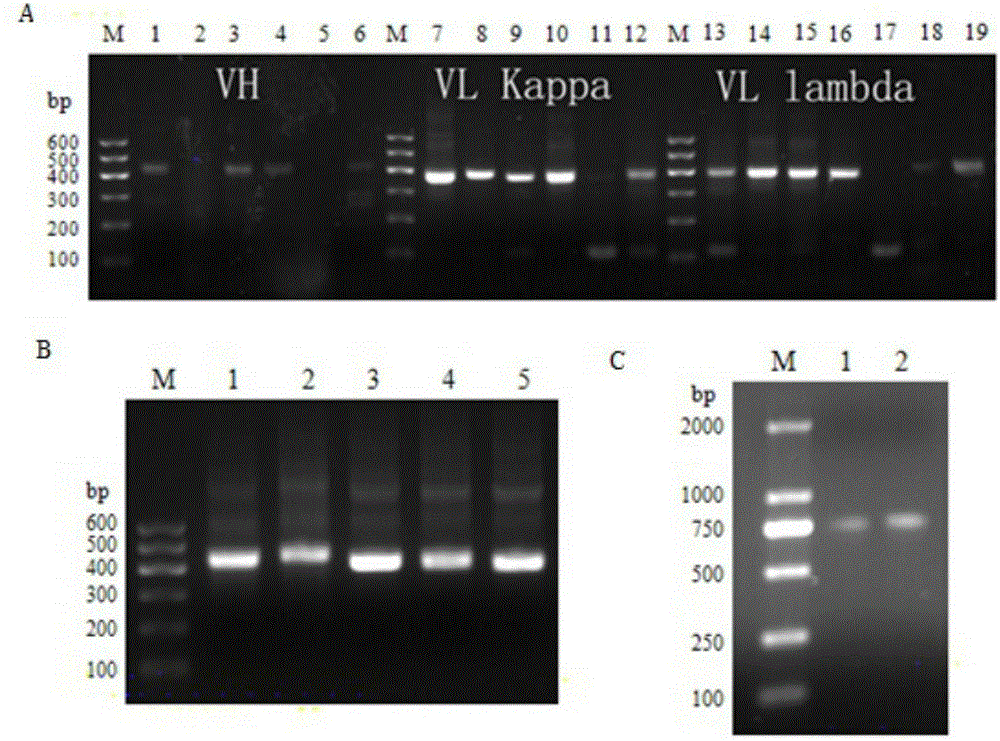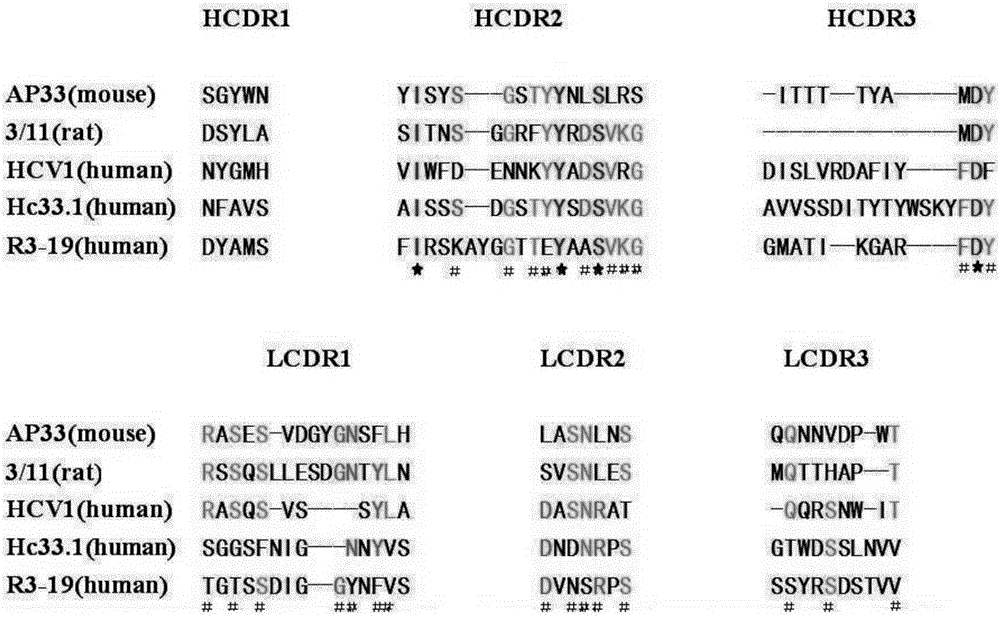Multi sub-gene resistant type HCV (Hepatitis C Virus) antibody gene R3-19 and application thereof
A genotype and antibody technology, applied in the field of biochemistry, can solve problems such as differences in the neutralization ability of different genotypes, and achieve the effect of broad binding characteristics and neutralization ability
- Summary
- Abstract
- Description
- Claims
- Application Information
AI Technical Summary
Problems solved by technology
Method used
Image
Examples
Embodiment 1
[0022] Embodiment 1, primer design
[0023] Design human IgG, IgM heavy chain constant region and κ, λ light chain constant region mRNA gene-specific reverse transcription primers according to John McCafferty's report, as well as PCR amplification primers for heavy chain and light chain variable region (McCaffertyJ, GriffithsAdFau-WinterG, WinterGFau - Chiswell DJ, Chiswell DJ. Phage antibodies: filamentous phage displaying antibody variable domains. Nature. 1990; 348(6301):552-4.). To facilitate insertion into the T7 phage vector, EcoRI and HindIII restriction sites were added to the 5' end of the forward primer for the variable region of the light chain (VL) and the 5' end of the reverse primer for the variable region of the heavy chain (VH). In order to generate the VL-linker-VH gene fragment, the PCR-amplified VL and VH fragments were connected by overlapping extension PCR, and the reverse overlaps were added to the 5' end of the VL reverse primer and the 5' end of the VH ...
Embodiment 2
[0028] Example 2, mRNA extraction and cDNA synthesis
[0029] Combining RNA / DNAStabilizationReagentforBlood / BoneMarrow(Roche) and mRNAisolationkitforblood / bonemarrow(Roche), use the magnetic bead method to directly isolate and extract mRNA from peripheral blood leukocytes, operate according to the instructions, and measure the extracted mRNA concentration and A260 / A280 value. The results showed that an average of 130 ng mRNA was obtained from anticoagulated peripheral blood cells per milliliter of the patient, and the A260 / A280 value was 1.90-2.00, indicating that the isolated and extracted mRNA can be used for library construction, and then stored at -80°C for later use. Take 50ng of mRNA extracted from all samples as a template, respectively use human IgG, IgM heavy chain constant region, κ, λ light chain constant region mRNA gene-specific reverse transcription primers, cDNA was synthesized by IIFirstStrandcDNASynthesisKit (NEB), combined, and stored at -20°C for future use...
Embodiment 3
[0030] Embodiment 3, single-chain variable region fragment (scFv) amplification
[0031] The heavy chain and light chain variable region genes were amplified by PCR, and the specific operation method was as follows: the heavy chain and the reverse primers for the variable region of the κ and λ light chains were premixed at equimolar concentrations, and the final concentration was 10 μM. In 50 μL of PCR volume, each contains 25 pmoL of single upstream primer and premixed reverse primer, 2 μL of cDNA, 10 μL of 5×ReactionBuffer, 10 μL of 5×HighGCEnhancer, 1 μL of 10mmoldNTP, High-Fidelity DNA Polymerase (NEB) 1 unit. Reaction conditions: 98°C pre-denaturation for 30 seconds, 98°C denaturation for 10 seconds, 60°C annealing for 30 seconds, 72°C extension for 30 seconds, a total of 25 cycles; finally 72°C extension for 2 minutes. PCR products were subjected to agarose gel electrophoresis, and HighPurePCRProductPurificationKit (Roche) was used to purify PCR. The electrophoresis re...
PUM
 Login to View More
Login to View More Abstract
Description
Claims
Application Information
 Login to View More
Login to View More - Generate Ideas
- Intellectual Property
- Life Sciences
- Materials
- Tech Scout
- Unparalleled Data Quality
- Higher Quality Content
- 60% Fewer Hallucinations
Browse by: Latest US Patents, China's latest patents, Technical Efficacy Thesaurus, Application Domain, Technology Topic, Popular Technical Reports.
© 2025 PatSnap. All rights reserved.Legal|Privacy policy|Modern Slavery Act Transparency Statement|Sitemap|About US| Contact US: help@patsnap.com



